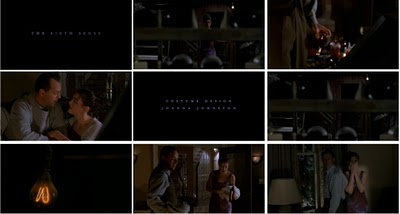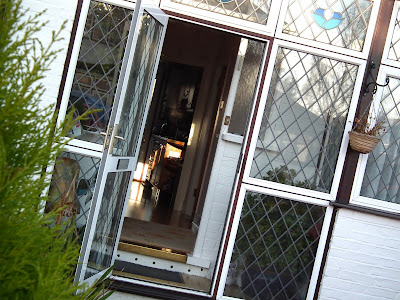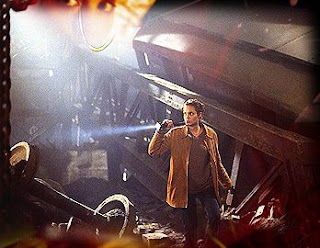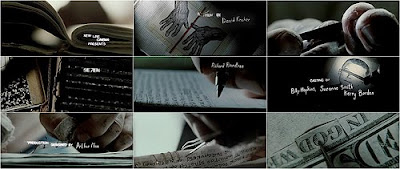
The title of the film:
The title for this movie is 'The Sixth Sense', and this film is very well known. The titles appear on the screen after we see who the film is created by and who's starring in it; when it does appear we see the title 'The Sixth Sense'. The title is positioned in the centre of the screen surrounded by darkness, but as it appears the music becomes more menacing. This could possibly connate a sense of danger that might appear within the film.
The way the setting/location is revealed:
The setting and location is revealed in a sinister way, and the audience is very nearly forced to watch the movie, purely because they want to know what is going to happen. We first see the location of a basement in the predominant characters house; basements are merely associated within thriller films to create the fear and suspense. Afterwards we see a vast room which could raise suspicion as to what could happen in this film.
Costumes/Props used in the opening:
During the opening sequence many props are used, for instance throughout the opening sequence we see the prop of a wine glasses, followed by a wine bottle. This suggests that they are vulnerable to anything as they have been drinking, and it could also trigger strange thoughts in their minds. Followed on by the characters wealth, the characters costumes show that they are higher class members of society and they could be seen as targets for awful things to happen as that is what happens typically in Thriller movies.
Camerawork/Editing in the opening:
The opening sequence is edited using continuity editing as it shows that all of the shots flow and there is not any sign of shots cut in a unprofessional way. Also, this type of editing shows a continuous flow of an eerie atmosphere that runs throughout the film. The camerawork in the opening sequence is very basic as close-ups and mid-shots are used a lot, this could possibly be done to calm the viewer down; but to get them ready for the suspense in the rest of the movie. In addition, when the woman reaches in for the bottle of wine, it is as if we are staring at her and she will then feel uncomfortable; so it is as of something is staring at her but the audience is that ‘thing’.
The title and font style:
The titles of text are very basic, being the colour blue and they are on a dark background; the text is placed in the centre of the screen. Moreover, the text is blue and blue is seen as a calm colour so this would be done to calm the viewer and draw them in, but this is going to trick them as the film is not calm at all.
How the opening sequence sets the story:
Seeing the basement scene where the woman comes down to get some wine sets the story, it is very calm possibly suggesting a calm life that they live together. The audience could automatically think that something would happen to the woman whilst in the basement; this is because it is very dark and creepy. It is as if something is staring at her.
How the opening suggests that it's a Thriller:
I believe that the music suggests that this opening sequence to the movie is a thriller, this is because it starts of very calm, subtle and quiet, but then the title appears on the screen, as it is very bold and ‘in your face’. The music becomes very loud and predominant, almost warning the viewer that something is going to happen but they don’t know when, and they will have to wait and see.
The characters introduced in the opening:
During the opening sequence we are introduced too two characters, firstly we see a woman and she is presented as very beautiful, wearing a formal dress and high heels. These clothes connote to the audience that she is of a higher class of society. But when we see the male character that she lives with, she automatically is safe and secure. He is also seen as a member of the higher class of society, due to the clothes he wears; along with the wine he is drinking.
Special Effects in the opening:
Special effects in the opening sequence of ‘The Sixth Sense’ are not really shown, possibly because there aren’t any used. This could be done to calm the viewer down even more, and they are just waiting to watch the rest of the movie.


 These are my location shots, and these are the potential locations for our groups opening sequence for a Thriller film. I feel that these locations would be excellent for the opening sequence, due to the mysteriousness that they create. The audience will wonder why a character would be in the woods that are clearly deserted. Also, if something sinister does happen to the character, they would know that this is a prime location for a body to be disposed of; and they will know where this body would be; whereas the other characters wouldn’t. These locations appeal to me, and to my audience because of the sheer eeriness of them. People have to travel through woods to get to destinations, and they are even next to park areas. Having such a normal everyday location used will really make the audience sit ‘on the edge of their seat’, and they will feel worried and this eerie atmosphere will have been created. But they will also be cautious of going through woods after seeing this location in our opening sequence, the opening sequence would could possibly have an impact on some viewers lives.
These are my location shots, and these are the potential locations for our groups opening sequence for a Thriller film. I feel that these locations would be excellent for the opening sequence, due to the mysteriousness that they create. The audience will wonder why a character would be in the woods that are clearly deserted. Also, if something sinister does happen to the character, they would know that this is a prime location for a body to be disposed of; and they will know where this body would be; whereas the other characters wouldn’t. These locations appeal to me, and to my audience because of the sheer eeriness of them. People have to travel through woods to get to destinations, and they are even next to park areas. Having such a normal everyday location used will really make the audience sit ‘on the edge of their seat’, and they will feel worried and this eerie atmosphere will have been created. But they will also be cautious of going through woods after seeing this location in our opening sequence, the opening sequence would could possibly have an impact on some viewers lives. 













